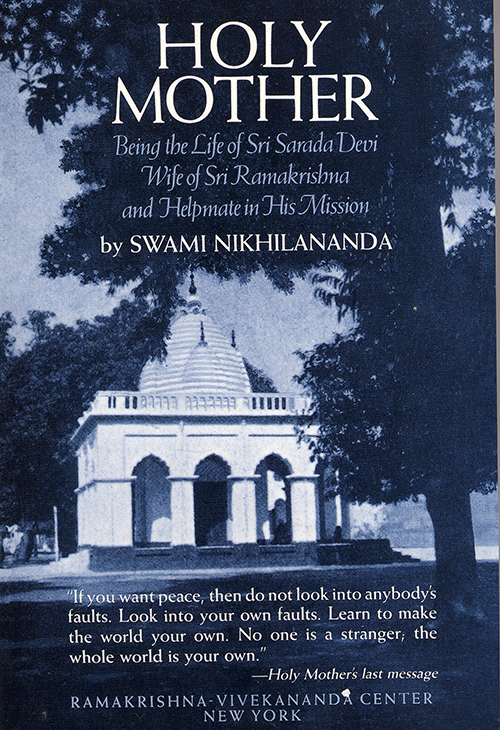
Holy Mother
Swami Nikhilananda. Life and teachings of Holy Mother, Sri Sarada Devi (1853 - 1920), wife of Sri Ramakrishna and helpmate in his mission. With 50 photographs. "Sarada Devi, humble and unpretentious, takes her place among the world's great souls." — Donald Szantho Harrington, Community Church, NY.
Paperback: $15.50
Preface
Holy Mother was the wife of Sri Ramakrishna (1836-1886), now regarded in India and abroad as a rare manifestation of divinity in modern times. She was his constant companion during the most eventful period of his life and a witness of his spiritual experiences. Sri Ramakrishna himself moulded her life and assigned her place in the carrying out of his mission after his death.
Outwardly Holy Mother lived as an average Hindu woman, devoting herself to the faithful discharge of her household duties, often unpleasant and frustrating. Inwardly she practiced total non-attachment and remained undisturbed by what happened in the physical world. Never did her mind deviate from contact with God. Thus she has become, today, a model for both householders and world-renouncing monks.
I deem it necessary to point out here two important features of her teachings and personality which may help the general reader, especially anyone unfamiliar with the background of Hindu culture, to respond sympathetically to her life. First, Holy Mother, when instructing her disciples, often asked them to regard Sri Ramakrishna as God incarnate. She accepted other Divine Incarnations, too, but looked upon Sri Ramakrishna, on account of his unceasing absorption in God, his total renunciation, and his acceptance of different faiths as valid ways to the realization of God, as the one suited to our present age. In her own experience she realized her husband's divinity. Therefore it was natural for her to speak of him as a visible symbol of the Godhead. But she was by no means dogmatic or exclusive. In teaching seekers who cherished other spiritual ideals, she always deepened their faith in these.
Second, Holy Mother is often described in this book by such epithets as the Mother of the Universe and the Divine Power These are not mere sentimental expressions on the part of her devotees, but have a philosophical significance. According to Vedanta philosophy, Brahman, or Ultimate Reality, is inactive It is not, Itself, involved in the activities of creation, preservation, and dissolution. These are carried on by Its inscrutable energy, called maya or Sakti. Brahman and Sakti are inseparable, like fire and its power to burn or a gem and its lustre. The two names are given to one and the same Reality according to Its two different functions. The whole universe of the living and non-living is the projection of this divine energy, which, like an earthly mother, produces creatures from its womb and then nourishes them. This energy, again, finally withdraws the created beings into the Godhead, thus liberating them from the bondage of the world. The Hindus therefore regard it as the Mother and Saviour of all. Though this energy is present in all creatures, to a Hindu it resembles a woman more than a man. Undoubtedly all women are channels of Sakti, but a woman totally undefiled by worldliness becomes its most potent channel. Holy Mother was such a woman. Thus she too has been described as the Saviour or the Divine Mother of the Universe. She looked on all children born of a woman's womb as her own.
There are several books published in India, both in English and in local vernaculars, about the life and teachings of Holy Mother. I have freely borrowed facts and ideas from some of them, and hereby express my indebtedness to the authors Swami Gambhirananda's book, published in English and in Bengali by the Sri Ramakrishna Math, Madras, and the Udbodhan, Calcutta, respectively, contains authenticated facts. Manadasankar Das Gupta's Bengali life analyses these facts admirably The life of Holy Mother by Swami Tapasyananda and Swami Nikhilananda, in English, also published by the Sri Ramakrishna Math, Madras, gives in addition a number of Holy Mother's Conversations. I have included in the present book some of my own reminiscences.
In order to indicate Holy Mother's place in the history and development of Indian womanhood, I have devoted the introductory chapter to a discussion of some of the great women of India. A glossary has been added to explain terms unfamiliar in the West.
Mr. James Holsaert has edited the entire manuscript with painstaking care and given many valuable suggestions to make the book more easily understandable, especially to Western readers. Swami Atmaghanananda, besides editing the manuscript, has worked hard in looking after many mechanical details in order to prepare it for the press. Mr. Joseph Campbell, too, has revised the manuscript and made helpful suggestions. I am grateful to all of them. Though I have accepted many suggestions from the editors, I take full responsibility for the reflections and interpretations in this book. The manuscript has had to be typed several times. Mr. and Mrs. Harold Knapik, Mabel Colloredo-Mansfeld, and Dorothy Kruger cheerfully performed this chore. I am grateful to them also. The publication of this volume has been made possible through the generosity of Mr. and Mrs. Chester F. Carlson, and I express to them, as well, my deep gratitude.
Holy Mother's life and teachings have a direct bearing on the present human situation. Physical scientists, and professional philosophers influenced by the scientific method of reason and experimentation are preoccupied to discover the laws which explain and control life and nature. They are revealing various dimensions of reality which tell us about man and the world and also how to utilize this knowledge for man's physical welfare There is a growing number of thoughtful people who regard intellectual knowledge, unillumined by spiritual insight, as inadequate to satisfy the deep yearning of the soul. They look to religion for inner peace. But unfortunately most of the religions, as practiced today, are cluttered with dogmas and creeds that conceal the truth. Men want a guide with direct experience of the true nature of the Godhead, the world, and the soul. Only thus can his words and actions become imbued with love and compassion. Moreover, this experience, if it is to transform men's lower nature and lead to the welfare of all, must be ex pressed in simple words. Perceptive readers may find in Holy Mother's life the fulfillment of these conditions. They will also find one who, instead of luxuriating in the enjoyment of inner peace, worked till the last moment of her life to transmit that peace to others.
This book, I believe, will be a source of inspiration to the growing number of Sri Ramakrishna's devotees and admirers among English-speaking people. Slowly Holy Mother's influence will infiltrate the general thought current of the world and give an impetus to spiritual seekers everywhere, irrespective of their religious affiliations.



